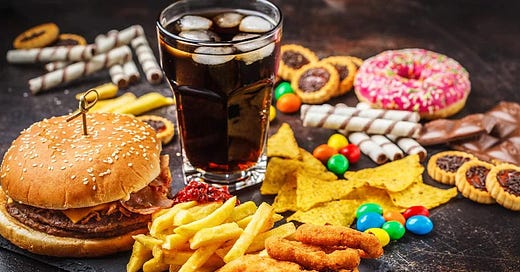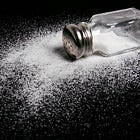UPDATED: May 20, 2025
Welcome to the Healthy Living Is Good Medicine Newsletter, a free publication covering a wide variety of health-related topics, with timely original articles intended to help people lead healthier and more fulfilling lives.
According to the latest American Association for Cancer Research progress report, early-onset cancers are on the rise, and some of the culprits have yet to be identified. Typically diagnosed in adults over the age of 65, some cancers are now increasingly seen in individuals younger than age 50. A recent review has looked at a number of possible contributors:
A new study has found that dietary fructose indirectly enhances the growth of existing tumors. Fructose consumption from table sugar has increased dramatically over the past half-century, and is now largely due to the widespread use of ultra-processed foods containing high-fructose corn syrup as a sweetener. Consuming sugary beverages in adolescence, as little as one drink a day, was associated with a 32 percent higher risk of developing early onset colorectal cancer. As I have said many times before, “Fructose is your foe, and fiber is your friend.” Please remember that.
Please Don't Try This Experiment
Morgan Spurlock, the filmmaker whose 2004 documentary, Super Size Me, was nominated for an Academy Award, recently died of cancer complications at the age of 53. To make the film, Spurlock consumed only McDonald's meals for a month as an experiment to see how it would impact his health. He suffered multiple medical issues in the experiment's immediate aftermath, including a swollen liver.
While there is no direct evidence that his cancer was due to eating McDonald's meals exclusively, according to a number of studies there is a clear connection between increased colorectal, breast and pancreatic cancer risk and consuming high amounts of ultra-processed foods (UPFs). However, the kind of evidence necessary for governments to ban UPFs is unlikely to be forthcoming because of the many hurdles involved in doing a high-power clinical trials.
This category of edible items includes fast foods, ready-to-eat meals, sodas, chips, ice cream, sugary cereals, and processed meats such as hot dogs, bacon, and cold cuts. The Mayo Clinic has an excellent article to help people identify which foods to avoid, and which ones are processed but are relatively safe to eat. They generally contain added sugar, salt, saturated fats, and other ingredients not naturally present in real foods.
Carcinogens
Methylglyoxal is a compound that's produced when the body breaks down sugary and fatty foods. It switches off a gene that helps to ward off cancer. Junk foods are also loaded with compounds such as heme and nitrates that can damage cells lining the large intestine, increasing the risk of colorectal cancer.
The rates of other cancers are also increasing among younger people. In addition to UPFs, some research points to water and air pollution, pesticides, herbicides, and contamination of foods with so-called "forever chemicals" such as PFAS, as possible culprits. Recent discoveries of nanoplastics throughout the human body have also raised red flags.
Cancer risk is amplified by a sedentary lifestyle and obesity. Excess visceral fat causes levels of growth hormones to rise, producing a state of constant inflammation that increases the risk of developing 13 different types of cancers, affecting the bowel, kidney, pancreas, esophagus, endometrium, liver, and breast.
In addition to the risks associated with tobacco use, alcohol consumption is implicated in one out of 20 cancers.
Colorectal Cancer in Children
Colorectal cancer (CRC) is no longer considered a disease of the elderly. The CRC incidence among younger people in the United States has been steadily rising over the past two decades, with the greatest increases seen in children. The rate of CRC increased by 500 percent among children aged 10 to 14 years, and more than 300 percent among teenagers aged 15 to 19 years.
While known risk factors include a family history of inflammatory bowel disease or colorectal cancer, there are many modifiable risk factors involved. They include obesity, tobacco and alcohol use, and poor dietary habits, such as inadequate amounts of fiber. A new study found that higher levels of the arginine and urea metabolic cycles, related to the consumption of red and processed meats, are found in younger adults with colon cancer.
The trend for increasing incidence of CRC was also found in the higher age brackets, with rates rising by 71 percent among people aged 30 to 34 and by 58 percent in ages 35 to 39 years. A recent systematic review and meta-analysis showed that a high UPF intake is significantly associated with a higher risk of CRC, although a dose–response relationship was not evident. Prospective studies with larger cohorts are clearly warranted.
It’s not just CRC rates that are rising among younger people. A new, large study found an increasing risk for 17 cancers in this demographic, with the most significant increase in risk for kidney, pancreatic, and small intestine cancers. Incidence rates for breast and pancreatic cancers have been rising across successively younger generations.
Mortality rates have increased for gallbladder, colorectal, testicular, and uterine cancers. The researchers concluded that the increase is most likely due to generational changes in diet, lifestyle, and environmental exposures to carcinogens. There is an urgent need to further identify and decisively address the underlying risk factors.
Although the numbers are still relatively low, colorectal cancer is projected to become the leading cause of cancer-related deaths for people in their twenties to forties by the year 2030. According to a recent study, the cause may begin early childhood with the presence of colibactin, a toxin produced by certain strains of E. coli bacteria, can produce mutations in DNA.
In another study, the effect of intestinal bacterial toxins was amplified when there is an inadequate amount of fiber in the diet. A third study showed that for every 10 grams of fiber eaten each day (about a cup of beans) there’s a 10 percent reduction in colorectal cancer risk. So, I’ll now say it this way, “Fiber is your friend, fructose is your foe.”
Fake and Junk Foods
According to the United Nations Food and Agriculture Organization, ultra-processed foods (UPFs) are those that contain ingredients never or rarely used in people’s kitchens, or have additives whose sole function is to make the product more palatable or appealing. Their ingredients can include stabilizers and preservatives, artificial coloring, emulsifiers, and artificial sweeteners.
These ultra-palatable concoctions are created by industrially processing ingredients to give them the appearance of food, with the sole purpose of making as big a profit as possible. They typically contain added sugars, salt, and fats that can hack people’s taste buds to create cravings.
A recent narrative review explores the relationship between dietary sugar and cancer risk. It explains how sugar affects cell signaling, inflammation, and the hormonal pathways associated with the development of cancer. However, the notion that sugar “feeds cancer” is a misinterpretation of the evidence.
Ultra-processed “fake foods” are also ultra-convenient, so parents often reach for them when they need to give their kids a snack. They are cheap, readily accessible, and heavily marketed, under labels of “natural” or “healthy” or even “organic.” Many UPFs have a plant origin and are eaten by vegetarians. They include meat substitutes, textured vegetable protein, and various “milks” based on grains or nuts. You need to look closely at the products’ ingredients even if they seem healthy, and choose only those with a simple ingredient list.
As a result, one in eight American children have become addicted to UPFs with little or no nutritional value, because they produce a dopamine surge in the brain that’s comparable to the effect of nicotine. UPFs can be considered addictive substances based on established scientific criteria. Some UPFs, such as candy and frozen desserts, are thought to act like “gateway drugs” for teens, leading them into other, even less healthy eating practices.
Many studies have shown the negative health effects of UPFs in adults, including a 47 percent higher risk for inflammatory bowel disease (IBD) and an alarming rise in colorectal cancer among young adults. A new study indicates the significant impact that UPFs can have upon the cardio-metabolic health of young children. Another study found that the children of women who had consumed the most UPFs during their pregnancy had a 26 percent higher risk for becoming overweight or obese.
If new parents can create a healthy lifestyle for their family early on, there’s a good chance that they can eliminate the risk of their children developing metabolic syndrome later in life, and the complications associated with obesity and type 2 diabetes.
A recent study noted that highly refined breads, sauces, condiments, artificially and sugar-sweetened beverages, animal-based products, and ready-to-eat meals were most closely associated with a higher risk of developing type 2 diabetes.
Healthy, home-cooked meals should be the norm when it comes to parents safeguarding their children from the perils of fast and fake foods. Packaged foods and fast food restaurants need to be avoided as much as possible.
After keeping fake foods out of the home, the next thing to scrutinize closely are the foods that schools are serving to people’s children. For example, the Lunchables brand of packaged meals was included in the National School Lunch Program serving nearly 30 million children. These UPFs contain relatively high levels of sodium, lead, and cadmium, according to Consumer Reports testing.
As a result of consumer pressure, with nearly 50,000 signatures on a petition delivered to the U.S. Department of Agriculture and a boycott that impacted sales, Kraft-Heinz announced that it is removing its Lunchables meal kits from the National School Lunch Program. More Power to the People!
Plasticizers such as phthalates are yet another reason to avoid fast food and heat-and-eat meals. Fast foods are often prepared by people wearing vinyl gloves, which are known to be extremely high in these chemicals. Another reason fast foods can be high in plasticizers is that they tend to be fatty. Many plasticizers are known to be fat-soluble. It is better to buy unpackaged fruits and vegetables that have less contact with phthalates, compared to those that come in plastic wraps or containers.
To change dietary policies in the United States, there would need to be randomized, controlled trials (RCTs) that definitively show a causal connection between UPFs and specific diseases. Given the poor state of funding for nutrition research and the great expense involved in performing RCTs, that’s unlikely to occur.
As observational evidence continues to accumulate about the adverse effects of UPFs, it could soon be unethical to even conduct such trials. Once again, you can’t count on the government to protect you, or your children. Consequently, it is up to you to take whatever measures are necessary.
Some Good News
The FDA has approved Shield, a blood test for colon cancer. Colonoscopy and stool testing rates in the U.S. are far lower than they should be, considering that colorectal cancer is the second-most common cause of cancer deaths. Only a third of people who should be screened for CRC have had it done. The new blood test will be a more convenient way for people to get tested for the presence of CRC, but it will not detect the precancerous polyps that can be identified and removed during colonoscopy.
A new study has uncovered the link between red meat and colorectal cancer. The heme (blood derived) iron found in red meat reactivates an enzyme called telomerase through an iron-sensing protein called pirin. Telomeres are pieces of chromosomes required for cell division. Telomerase helps maintain telomeres, enhancing cell division. Pirin aids cancer cells in using telomeres to grow uncontrollably. This study paves the way for new pharmaceutical interventions.
With early diagnosis and treatment, CRC has nearly 100 percent survival. Risk reduction can be accomplished by avoiding UPFs and processed meats, cutting back on consumption of red meat and sugar, increasing dietary fiber, eating tree nuts, and exercising for at least half and hour almost every day. While major revisions to your eating patterns may be necessary, don’t try to go too big or too fast. Lifestyle modifications should be incremental. The small changes will add up, so you might as well start now.
An Anti-Cancer Vaccine
While unrelated to diet and cancer, I want to mention some spectacular medical achievements in the prevention of virus-caused cancers through vaccination. Unfortunately, anti-vaccine activists have been spreading massive amounts of disinformation intended to discourage their use.
The human papillomaviruses (HPV) causes 99 percent of cervical cancers. There are very effective vaccines (Gardasil and Cervarix) that protect against infection by these viruses, and therefore prevent the cancers that they can cause. This has resulted in markedly declining rates of those cancers. The hepatitis B vaccines (Engerix-B, Heplisav-B, and Recombivax HB) protect against the hepatitis B virus (HBV) that can cause liver cancer.
― ― ―
This Post can be updated at any time. Please check back here again to find the most up-to-date information.
You can find many more articles about Healthy Living in my Post Archive.
Please share my Website Link with others via your social media accounts. You can help your friends and followers become healthier by suggesting that they subscribe to my totally free Newsletter.








